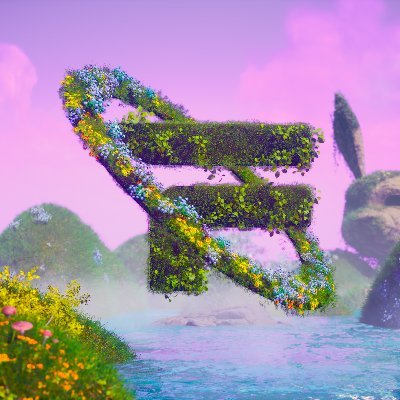Financing 54 million dollars, how does Futureverse build the AI metaverse?
Compiled by: Peng SUN, Foresight News
The voice of the metaverse has been silent for too long. Recently, Futureverse, a startup that combines AI and the metaverse, raised $54 million, attracting attention. This new round of financing was led by 10T Holdings, with participation from Ripple Labs and others.
Futureverse has an interesting origin; it was formed by the merger of 11 different companies, starting with 8 companies merging at the end of 2022, followed by the addition of 3 more companies. These 11 companies are:
- Game studio Altered Phoenix
- AI provider Altered State Machine
- Multi-chain payment product Immersve connected to the MasterCard network
- Design studio Non-Fungible Labs
- Animation studio Shadows Interactive
- Digital payment system Centrapay
- Developer of decentralized digital identity protocol and asset custody protocol Centrapass
- Developer of decentralized communication system Sylo
- Web3 car community ATEM Car Club
- Venture studio Centrality
- Digital streetwear community DRx
It is noteworthy that most of these merging companies are interconnected. For example, Centrapay, Centrapass, and Sylo are all operated by Centrality. The co-founder of Futureverse, Aaron Mcdonald, is also a co-founder of Altered State, Centralpay, Centrapass, Immersve, and Non-Fungible Labs.
Through the merger of these 11 companies, Futureverse integrates infrastructure from different fields into a collaborative ecosystem, providing the essential components needed for any metaverse application. Today, I have summarized the Futureverse white paper to explore how Futureverse is building an open metaverse.
1. Basic Composition of Futureverse
Futureverse offers a set of tools at the infrastructure, protocol, content, and application layers, fully considering user experience during construction and ensuring comprehensive integration for interoperability.
- Decentralized blockchain network The Root Network, optimizing user experience and lowering the barrier to entry into Web3;
- Decentralized identity protocol and asset passport, forming the foundational data layer for interoperability and applications;
- Decentralized delegation protocol, allowing applications to access assets, users, and content in a layered manner;
- Decentralized communication, notifications, and storage protocol, enabling communication between users and applications;
- Decentralized artificial intelligence protocol, allowing applications and avatars to leverage this technology in a community-managed and user-driven manner;
- A payment network and wallet designed to help users enter Web3 and connect physical goods, acting as a financial channel for the metaverse.
- Content assets: Rich user-owned digital assets centered around storytelling.
2. The Root Network
The Root Network is the core blockchain infrastructure of Futureverse, built with the following components and Runtime, focusing on the user's onboarding experience:
(1) Substrate Core
The Root Network is based on the Substrate framework, which boasts a large and mature developer community, with the technical capability to optimize user experience through custom chain runtimes;
(2) EVM Supporting Smart Contracts
The EVM runs within The Root Network protocol, capable of reading and executing Solidity smart contracts. Developers on The Root Network can access smart contract functionality, allowing any code previously written for Ethereum to run on The Root Network.
(3) Custom Runtimes
Custom Runtimes for non-fungible assets, GAS economy, fungible assets, DEX, oracles, etc., will provide creators with the elements to build applications and content without needing to become smart contract developers.
1. Non-Fungible Asset (NFT) Runtime
The Root Network NFT runtime provides a unified experience for NFTs across the entire network.
In other networks, NFTs exist at a single contract layer. In The Root Network, NFTs exist within the core network runtime. This provides a universal standard for establishing interoperability, including unified minting, royalties, and structures (metadata and content formats). The NFT runtime features:
- Network-wide royalty enforcement
- Local multi-wallet revenue sharing and tiered royalty services for creators
- Native NFT and NFT exchanges
- Local static and cold minting options
- Building NFT DApps without needing to develop or deploy smart contracts
Fees from the NFT runtime will be distributed to network stakers and validators. The Root Network will also integrate the XRPL XLS-20 NFT standard, compatible with the XRPL NFT ecosystem and infrastructure.
2. Multi-Token Economy
The Root Network proposes a multi-token economy to optimize Gas fees and lower the barrier for initial user onboarding into Web3.
The primary network token of The Root Network is ROOT, which serves as the network security and governance token in the PoS consensus, not a Gas token. Futureverse collaborates with Ripple and XRPL to provide base block rewards in the form of XRP. XRP will also be used to pay for the network's Gas fees.
The Root Network offers an in-chain Gas fee exchange service, eliminating the need for users to understand the concept of Gas and purchase Gas before using DApps, and alleviating concerns about Gas fee volatility. Users can join The Root Network and use the native tokens of applications, while developers can delegate and pay fees on behalf of users. Developers establish a liquidity pool between their native tokens and Gas tokens. Node validators can receive these Gas tokens as rewards for producing blocks. For example, users coming from Ethereum can use ETH, users connecting via ASM can use ASTO, and users who downloaded the SYLO wallet can use SYLO. By default, if there is no liquidity pool for the native token, users can use the network Gas token XRP.
Stakers and validators can accumulate an index of network tokens and engage with activities across the entire ecosystem, allowing users to join without needing to understand the underlying network economy or interact with exchanges.
3. Fungible Assets
Similar to the NFT runtime, users can create and launch standardized fungible tokens without deploying smart contract code, compatible with XRPL fungible tokens. 1% of each new asset created by the fungible asset runtime will be allocated as fees to network node validators.
4. DEX
The network exchange runtime provides an in-chain DEX, allowing users and developers to trade assets, establish liquidity pools, and initiate token price discovery without deploying smart contract code. Exchange fees are collected by node validators. The in-chain DEX will also integrate with the XRPL DEX to extract liquidity from the XRPL DEX, thereby initiating network liquidity.
5. Decentralized State Oracle
The state oracle allows developers to link events occurring on other chains with actions within The Root Network, enabling cross-chain interoperability and allowing developers to build interoperability into applications and content.
For example, allowing DAO votes on ETH to initiate asset transfers on The Root Network; NFTs on one network can interact with utilities on The Root Network.
(4) Liquidity and Asset Bridge
The Root Network natively supports cross-chain asset transfers through its universal cross-chain bridge runtime, allowing assets from FLUF World on the Ethereum network or fungible and non-fungible assets on XRPL to be transferred to The Root Network.
3. ROOT Token Economics
The total supply of ROOT tokens is 12 billion, which can be used for protocol governance, PoS network staking, transaction fees, minting fees, FLUF World game tokens, and data markets. Its token distribution model is as follows:
- Community Rewards: 20% - Monthly ecosystem challenges will determine the total rewards players can earn, as decided by FutureScore;
- Land Mechanics: 20% - Related to game mechanics in The Third Kingdom;
- Ecosystem Development Fund: 10% - Encouraging developers, artists, and IP holders to engage in development;
- Block Reward Bootstrap: 10% - Validators and stakers will receive up to 10% of tokens as bootstrap funding over 260 weeks;
- CENNZ Burn to Mine: 10% - CENNZ token holders can burn CENNZ in The Root Network, receiving one ROOT for each CENNZ burned at a 1:1 ratio;
- Futureverse Team: 15% - Lock-up period of 100 weeks, release period of 100 weeks;
- LP Allocation: 5%;
- DAO Treasury Allocation: 5% - Lock-up period of 50 weeks, with the DAO controlling its distribution;
- Advisor Allocation: 5% - Issued to core advisors and significant IP buyers, with a lock-up period of 100 weeks and a release period of 100 weeks.
4. Decentralized Identity Protocol and Asset Passport
Futureverse adopts the W3C Decentralized Digital ID (DID) protocol to provide users and assets with a way to interact across metaverse applications, ensuring both privacy and interoperability.
This protocol allows developers and users to create off-chain identities that can be transferred between applications serving users and assets, and can also specify proofs for content formats, similar to stamps on a passport.
Users can also utilize a stateless eKYC engine to receive proofs corresponding to their ID for potentially sensitive data like age, without storing personal identity data, allowing developers to provide age-restricted content experiences.
5. Decentralized Delegation Protocol
Doughnuts are a patent-pending delegation proof protocol. They exist between two or more cryptographic key pairs, capable of proving that one address has delegated something to another address.
Doughnuts allow for fine-grained access to assets, such as allowing an application to access only once or permitting time-based access, thereby enhancing the security of wallet transactions.
6. Decentralized Communication, Notifications, and Storage Protocol
In Futureverse, the consensus on the ledger is provided by The Root Network. However, transaction services that are not value-based, such as communication and notifications, do not require full network consensus but still need to be decentralized.
Futureverse provides decentralized off-chain services for DApps through The Sylo Network, including real-time events, asynchronous messaging, notifications, state management, real-time calls, and real-time data exchange. These decentralized services are provided by Seeker nodes and paid for using Tickets.
The Sylo Network is the first network to gamify node infrastructure, closely linking the node infrastructure itself (Sylo nodes) with metaverse characters (The Seekers, also NFTs), and introducing social mechanisms and game rewards to incentivize participation.
Typically, rewards for running nodes are limited to token rewards, consistent with the network token incentive mechanism. By combining Seekers NFTs with Sylo nodes, Futureverse creates in-game functionalities that encourage more network participation, thereby enhancing network resilience.
Seekers also introduce concepts of Orders, Factions, and Clans into the game; only those who contribute to the network itself can join. Orders, Factions, and Clans will have greater rights, allowing them to participate more significantly in the game and be publicly recognized for their meaningful contributions to the infrastructure of the open metaverse.
7. Decentralized Artificial Intelligence Protocol
Futureverse utilizes the Web3 artificial intelligence protocol Altered State Machine (ASM), whose product is a platform and protocol that enables the ownership, tradeability, composability, and interoperability of AI through NFTs, namely the ASM Protocol and ASM Platform. ASM will allow any individual (rather than a company) to prove ownership, build, and manage their own AI. By integrating ASM Agent NPCs, it can become autonomous avatars, pets, vendors, quest givers, storytellers, companions, etc. ASM products also include NFT asset deployment platforms.
8. Content
Futureverse builds content in three ways:
- Following the path: Stories and legends > Characters > Content > Small spaces > Events > Large spaces > Games [AM1], where each step requires time for the community to co-create narratives and content;
- Collaborating with world-leading film, television, social media, and sports IP holders;
- Ecosystem development fund.















